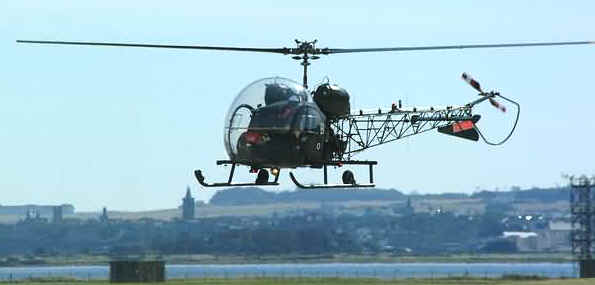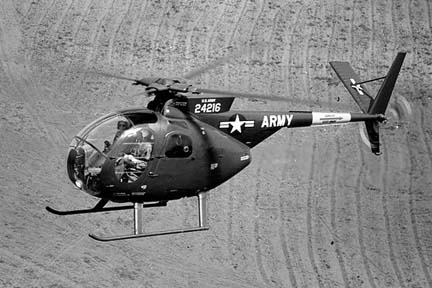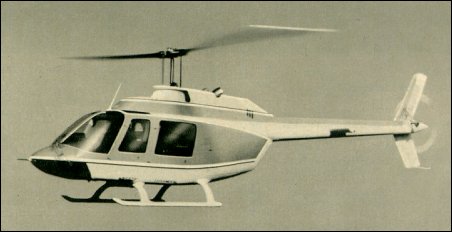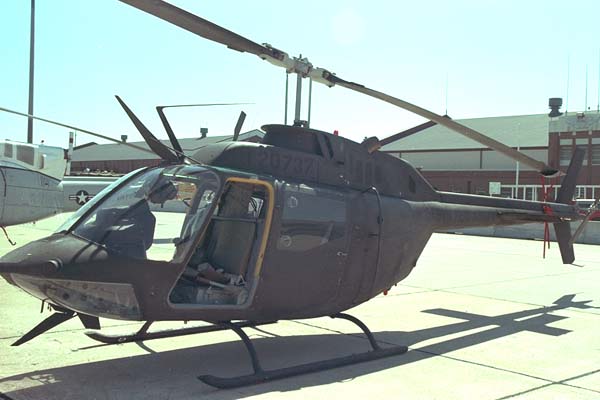 |
|
|||
|
|
||||
|
|
Light Observation Helicopter (LOH) program
(1960-1968). In 1960, the U.S. Army requested proposals for the LOH
program, a small, manoeuvrable, personnel transport, cargo, MedEvac, light
ground attack, artillery, and photo reconnaissance helicopter.
The LOH program was won by the Hughes (model 369) YOH-6A Cayuse (The Flying Egg). |
||||||||||||||||||||||
| Though not selected, the Bell (model 206) YOH-4A (1961), powered by an Allison T63-A-5 250 shp turbine engine, evolved into the successful Bell (model 206A) Jet Ranger. When the LOH program was reopened for an additional buy in March 1968, the Army selected the Bell model 206A, which was type classified as the OH-58A Kiowa light observation helicopter. | |||||||||||||||||||||||
Bell OH58A - Kiowa
On Lease from the US Army. In 1971 the Australian Army leased Eight Bell OH-58A Kiowa’s United States Army for use by 161 (Indep) Recce Flt in Vietnam. There was, reportedly, an attempt to rename the Australian Kiowa's "Kalkadoon" after the Aboriginal tribe. The name did not take.
This aircraft was a four-seater, observation type helicopter powered by a 317 shaft horsepower gas turbine engine. Some measure of the efficiency of the gas turbine engine may be gauged from the fact although the engine in the OH-58 produced 17% more power that that in the Sioux but it weighed about one third the weight (136 lbs). Basic Aircraft Characteristics:
* Varies with altitude, air temperature, airspeed and all up weight. Maintenance Support. As the aircraft were only on lease from the US Army and would eventually be returned the initial agreement required that all maintenance procedures and documentation conform to the requirements of the US Army. The level of maintenance allocated to 161 (Indep) Recce Flt was only to organisational level, first line maintenance. Direct support and higher was required to be carried out by the US Army and the 388th Maintenance Company at Vung Tau. The allocation of direct support maintenance to the US Army was not completely satisfactory, particular whilst the Flight was based at Nui Dat. Considerable difficulty was experienced in providing adequate training for RAEME personnel from the Flight due to the lack of suitable training schools and the different maintenance philosophy of the two Armies. Once the loan agreement was approved pilots and maintenance support personnel from 1761 (Indep) Recce Flt began aircraft conversion training with the 5th Aviation Detachment at Vung Tau. The engine tradesmen also did a one week engine course at the Army Aviation Refresher Training (AART) School at Phu Loi. Aircraft Received. Released from US Army stocks, the first batch of four OH-58A’s were accepted by pilots from 161 (Indep) Recce Flt at Saigon's Tan Son Nhut Airport on 24 July. The aircraft were flown to Nui Dat via Vung Tau . The last of the eight OH-58A's arrived at Nui Dat on 28 August. The tail numbers of the aircraft received were in a continuous block starting with 70-15236 through to 70-15243 inclusive. Except for the aircraft’s serial number (viz 70-15239) all other US Army markings were removed and replaced with Australian roundels and tricolour flashes which were applied to both sides of the fuselage and vertical stabiliser respectively. Kiowa Roles in Vietnam. The OH-58A Kiowa's were only operated by the Flight for eight months but in that time they were used in a diverse range of roles and they ably demonstrated their suitability in the respective roles. The roles that these aircraft were use for included the following:
Aircraft Tasking. On 28 July, just four days after receiving the first aircraft, the inaugural operational sortie by an ‘Australian’ OH-58A (70-15236) was flown by Mick Reynolds in direct support of 4 RAR. Closing Down and Going Home. With the decision made that all Australian military forces were to be withdrawn from Vietnam 161 (Indep) Recce Flt began preparing the moved from Nui Dat to Vung Tau and this task was completed on 05 October. The Flight remained fully operational in support of 1ATF throughout the move. On 15 November, Lt Grant Steel (RNZIR), while conducting a visual reconnaissance in 70-15241, North of Long Son Island, located an occupied enemy camp and he was engaged by at least three enemy automatic weapons. Although his aircraft was extensively damaged he was able land the aircraft in a safe area, thus saving his passenger and himself from injury. The aircraft had been hit by at least 12 rounds of small arms fire. It was recovered back to Vung Tau where because of the extensive damage it was returned to the US Army for subsequent repair or disposal. The fate of the aircraft is unknown. With the wind down of the Flight's commitment and the imminent withdrawal of the majority of the Flight from Vietnam three of the seven remaining helicopters were returned to the US Army on 9 December 1971. A formation of four aircraft departed Vung Tau for Saigon via Nui Dat, Courtney, Xuan Loc and Long Binh to return the aircraft to the US Army. A rear-party led by Tub Matheson and two other pilots plus 12 OR's and the four remaining OH-58A's was formed on 16 December and they assumed the responsibility for all operational flying tasks of the Flight. The CP and the workshop element moved into the Eastern side of the RAAF hangar vacated by 9 Sqn. The last operational flight in Vietnam for 161 (Indep) Recce Flt was flown by Tub Matheson on 29 February 1972 in 70-15237. On 02 March 1972 the last four ‘Australian’ OH-58A’s (236, 237, 239 & 242) were flown to Saigon and handed back to the 166th Air Movements Section of the US Army, thus bring to a close a very important chapter in the annals of Australian Army Aviation. When the Porter replaced the Cessna and the Kiowa replaced the Sioux 161 (Indep) Recce Flt had the distinction of being the first "all turbine" unit in Australian Army Aviation, albeit with the US Army OH-58A in South Vietnam. Whilst in Vietnam the 'Australian' OH-58A's flew a total of 3,534 hours and 3,766 sorties. Post
Vietnam. In the late 1960’s the Australian Army had established a requirement for a Light Observation Helicopter (LOH) to replace the Bell 47G Sioux. In February 1971 it was announced that 75 examples of the Bell OH-58A Kiowa would be ordered for the Australian Army. The model chosen was the 206B-1 version, a military variant of the 206A Jet Ranger with an upgraded engine and lengthened rotor blades. To aid operating in unprepared areas, the 206B-1 would also incorporate higher skids. On 24 July 1971, 161 (Indep) Recce Flt, in Vietnam, took delivery of the first of eight Bell OH-58A Kiowa’s on lease through the US Army. To launch the Australian programme it was decided to import the first 12 Kiowa’s in knock-down form with re-assembly planned for Bell Helicopter’s facility at Brisbane Airport. On 22 November 1971, the first Bell 206B-1 Kiowa (nee OH-58A) was handed over to the Australian Army Aviation Corps at Brisbane Airport. Australian built machines were produced under the CAC designation of CA-32, the first of which (A17-013) was first flown from Fishermans Bend Victoria on 20 March 1973. After nearly three decades of service with the Australian Army Aviation Corps the Kiowa is still soldiering on. The aircraft is currently operated by the School of Army Aviation at Oakey for training purposes and operational tasks by 162 Recce Sqn in Townsville and 161 Recce Sqn in Darwin. In September 1999, 162 Recce Sqn deployed to East Timor as part of the INTERFET Forces. 162 Recce Sqn was replaced by 161 Recce Sqn in December of that year and is currently in East Timor as a member of the United Nations Peace Keeping Forces, albeit a lesser commitment. |
|||||||||||||||||||||||
 |
|
OPERATIONAL SERVICE IN SOUTH VIETNAM Thirty Seven (37) Bell 47 G3B-1 Sioux Helicopters were sent to in South Vietnam with 161 Recce Flight & 161 (Indep) Recce Flt during the period of September 1965 and September 1971. The first two aircraft to go to Vietnam were A1-394 and A1-395. The last Sioux to be flown in Vietnam was A1-738 on 13 Sept 71, by Mick Reynolds. Eight of the Sioux's sent to Vietnam were shot down or damaged beyond repair and were written off (CAT 5). Thirteen of the Sioux's which went to Vietnam did a second tour of duty with the Flight. Whilst in Vietnam the Sioux's flew a total of 43,911 hours and 66,069 sorties. |



